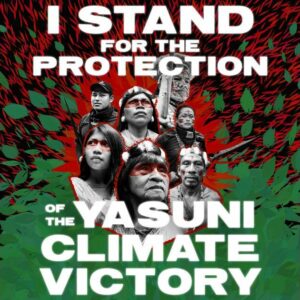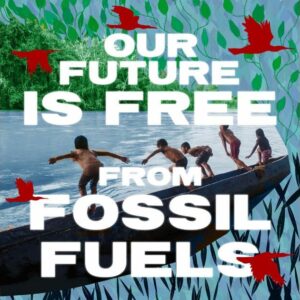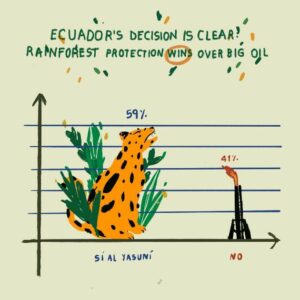By Darío Ramírez and Carlos Mazabanda
On the 4th October 2024, Amazon Frontlines published a detailed analysis titled: “Amazon Fires Devastate Indigenous Territories and Protected Areas: A Crisis in Numbers”, documenting the immediate devastation caused by forest fires in Indigenous territories and protected areas.
In our first report, we presented data demonstrating the alarming scope of the fires and their immediate impacts. Now, in this second report, we are expanding our analysis, exploring the long-term repercussions that these fires will have on Amazonian ecosystems and on the communities that depend on them.
The link between the destruction of forests and the drastic alteration of ecological cycles — such as evapotranspiration — is becoming increasingly evident, threatening to bring the Amazon to a point of no return unless urgent and comprehensive action is taken.
Our new research focuses on the drivers of these massive fires, as well as on the emerging environmental trends that threaten to push the Amazon to the brink. Using the latest data, we examine how agricultural expansion, climate change and extractive practices continue to fuel a destructive cycle that is both transforming the Amazon, and accelerating the global climate crisis.
2024 witnessed some of the highest rates of forest fires in the Amazon from the past two decades. According to the National Institute for Space Research (Brazil), 346,112 fire hotspots were recorded between January and September, surpassing the historic record of 2007.
The Industries Fueling the Amazon fires
The majority of fires in the Amazon are not caused by natural events but are instead human-driven. The expansion of agribusiness—particularly soybean cultivation and beef production—is a leading driver of deforestation, which is interconnected with the increase of forest fires.
Agribusiness projects in the Amazon often rely on fire to clear land, cutting down forests and burning vast areas once the vegetation has dried. This method significantly heightens the risk of uncontrolled fires spreading, endangering ecosystems and communities alike.
Scientific studies have demonstrated that the loss of trees alters the evapotranspiration cycle, reducing cloud formation and affecting the ecosystem’s capacity to produce rain. Drier conditions increase the frequency of fires, and make them harder to control.
In recent years, scientists have warned of a rapidly approaching “tipping point” in the Amazon. Some scientists suggest that this may occur once over 20-25% of the forest has been destroyed, the natural cycle of evapotranspiration is radically altered, preventing the healthy maintenance of the ecosystem.
Climate change has also intensified the problem. Higher temperatures and prolonged droughts, exacerbated by the El Niño phenomenon, create drier conditions in the rainforest, facilitating the spread of fires. Much of the Amazon’s vegetation is becoming increasingly flammable, allowing fires that once remained confined to deforested areas to spread into ancient, untouched forests—ecosystems that were never meant to burn.
These dynamics create self-reinforcing cycles of fire and warming. Deforestation accelerates climate change, which then fosters conditions more favorable for forest fires. These fires, in turn, drive further deforestation, perpetuating the destructive cycle.
One of the most alarming trends is that, despite efforts by some Amazonian governments to curb deforestation, fires continue to surge. In 2023, Brazil managed to halve its deforestation rate, yet the area consumed by forest fires increased by 36%. This highlights that deforestation and fires do not always align. The unchecked spread of fires, coupled with weak environmental protection policies, has triggered a crisis that threatens the integrity and biodiversity of the Amazon region, while posing significant risks to global climate stability.
Fire Hotspots and their Impacts on Indigenous Lands and Protected Areas
The global impact of Amazonian fires is profound. The carbon released from burning trees and vegetation directly contributes to global warming. Estimates indicate that in 2024 alone, forest fires have already released millions of tons of CO2 into the atmosphere, accelerating climate change and creating conditions that further increase fire risk.
As global temperatures rise, forest fires in the Amazon grow increasingly frequent and destructive. This self-perpetuating cycle, fueled by deforestation, climate change, and unsustainable agricultural practices, poses a serious threat to the Amazonian ecosystem and has far-reaching consequences worldwide. The most affected are the Indigenous communities who face daily challenges in protecting and sustaining the vital ecosystem that is their home.
At Amazon Frontlines, our team has been analyzing the increase in fire hotspots, with a particular focus on their impact on Indigenous territories and Protected Areas. We rely on data from the Fire Information for Resource Management System (FIRMS), an interactive platform that monitors fires by compiling near real-time data from various NASA satellites. It’s important to note that our analyses utilize only the fire hotspot information with “high” confidence values, which are linked to recurring thermal anomalies during both day and night.
A dramatic increase in fire hotspots from 2023 to 2024
For our analysis, we selected August 1st as the starting date, when 600 fire hotspots were recorded—the highest number at that time—and October 8th as the closing date, which showed a declining trend with 426 fire hotspots. Between August 1st and October 8th, 2024, a total of 34,896 fire hotspots were recorded.
In comparison, during the entire year of 2023—from January 1st to December 31st—there were 72,631 fire hotspots recorded. This means that 48% of all fire hotspots detected in 2023 occurred within just 68 days of 2024.
During the period analyzed in 2023, 34,986 fire hotspots were recorded in the Amazon region. Of these, 92% were in Brazil and Bolivia, with 72% in Brazil and 20% in Bolivia. Additionally, 4% of the total fire hotspots occurred within Protected Areas, while 14% were found in Indigenous Territories.
| August 1 thru October 8, 2023 | Fire Hotspots | % Of the Total | In Protected Areas | % Of the Country’s Total | In Indigenous Territories | % Of the Country’s Total |
| Brazil | 25,166 | 72% | 1,333 | 5% | 2,984 | 12% |
| Bolivia | 7,095 | 20% | 134 | 2% | 1,484 | 21% |
| Peru | 2,200 | 6% | 29 | 1% | 368 | 17% |
| Remainder of Countries | 525 | 2% | 53 | 10% | 169 | 32% |
| TOTAL | 34,986 | 100% | 1,549 | 4% | 5,005 | 14% |
| August 1 thru October 8, 2024 | Fire Hotspots | % Of the Total | In Protected Areas | % Of the Country’s Total | In Indigenous Territories | % Of the Country’s Total |
| Brazil | 71,610 | 72% | 3,344 | 5% | 12,677 | 18% |
| Bolivia | 24,225 | 24% | 939 | 4% | 9.035 | 37% |
| Peru | 3,332 | 3% | 52 | 2% | 537 | 16% |
| Remainder of Countries | 182 | 0% | 21 | 12% | 44 | 24% |
| TOTAL | 99,349 | 100% | 4,356 | 4% | 22,293 | 22% |
In 2024, during the analyzed period, 99,349 fire hotspots were detected in the Amazon region. Of these, 96% occurred in Brazil and Bolivia, with 72% in Brazil and 24% in Bolivia. Of the total fire hotspots recorded, 4% were in Protected Areas, while 22% were in Indigenous Territories.
In order to visualize this information, we have developed this dashboard presenting the evolution of fire trends on an interactive map, as well as data on how fires affected protected areas and Indigenous territories.
In the Amazon Region
- Fire hotspots increased by 184%
- Fire hotspots in Protected Areas increased by 181%
- Fire hotspots in Indigenous Territories increased by 345%
In Bolivia
- Fire hotspots increased by 241%
- Fire hotspots in Protected Areas increased by 601%
- Fire hotspots in Indigenous Territories increased by 509%
In Brazil
- Fire hotspots increased by 185%
- Fire hotspots in Protected Areas increased by 151%
- Fire hotspots in Indigenous Territories increased by 325%
In Peru
- Fire hotspots increased by 51%
- Fire hotspots in Protected Areas increased by 79%
- Fire hotspots in Indigenous Territories increased by 46%
Climate Change and Global Consequences
The Amazonian region is known as the lungs of our planet, given the region’s crucial role in carbon capture and global climate regulation. Nonetheless, fires are transforming the vast region into a source of greenhouse gas emissions.
In the first nine months of 2024, Brazil and Bolivia are estimated to have respectively emitted 180 and 30 megatons of CO2, respectively—levels that surpass the annual emissions of Norway. These emissions are not only accelerating climate change but also fueling a dangerous cycle that increases the risk of future fires.
Forest fires are also destroying the habitats of thousands of critical species, many of which are found nowhere else in the world. Fires in 2024 ravaged 22.38 million hectares, marking a 150% increase compared to the same period in 2023. This loss of biodiversity is irreversible and jeopardizes the ecological balance of not only the Amazonian region, but the entire planet. We are confronted with a troubling reality: one of the world’s vital ecosystems for regulating climate is now exacerbating the effects of greenhouse gas emissions through fires.
To halt forest fires and protect the Amazon region, it is crucial to tackle the root of the problem: deforestation. Agricultural expansion and illegal mining are degrading ecosystems, leaving forests more vulnerable to fires, and destroying the river systems vital for both biodiversity and Indigenous communities.
It is urgent to implement policies that halt deforestation and promote the restoration of degraded areas. Protecting rivers and water resources—critical for the ecological balance of the Amazon—must be made a priority. Indigenous communities, who have long been the most effective stewards of the rainforest, must be strengthened and supported to continue their work in cultural and ecological conservation. This is a fight that affects us all, as the struggle for the Amazon is, ultimately, a fight for the climate safety we all share.




